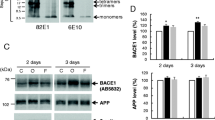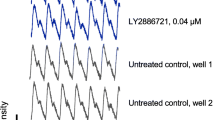Abstract
Amyloid ß peptide (Aß), generated by proteolytic cleavage of the amyloid precursor protein (APP), plays a pivotal role in the pathogenesis of Alzheimer's disease (AD). The key step in the generation of Aß is cleavage of APP by ß-secretases (beta-site APP-cleaving enzyme 1 (BACE1) and BACE2). There has been suggestion of interaction between aluminum and several AD-associated pathways. However, the underlying mechanisms still remain unclear. Here, we report the effects of aluminum chloride (AlCl3) in Aß-induced toxicity using differentiated neuronal SH-SY5Y cells. The metal significantly enhances Aß-induced cell death at concentrations ranging from 50 to 300 µM after 24 and 48 h. After 72 and 96 h treatment, cell death is increased already at 10 µM. Early coexposure of cells to 10 µM AlCl3 and 2 µM Aß differentially affected ß-secretase mRNA levels as compared to single Aß treatment after 1 and 3 h. BACE1 levels were slightly reduced after 1 h and significantly increased after 3 h exposure, whereas BACE2 levels were increased at both times considered. Both genes’ mRNA levels were downregulated at longer times (6, 12, and 24 h). Although these results indicate that aluminum toxicity is correlated to changes in both BACE1 and BACE2 expression levels, the subsequent common downregulation observed suggests that aluminum involvement in the Aß cascade is subtle, and other underlying mechanisms might be involved.







Similar content being viewed by others
References
Banks WA, Niehoff ML, Draqo D, Zatta P. Aluminum complexing enhances amyloid beta protein penetration of blood–brain barrier. Brain Res. 2006;1116:215–21.
Basha MR, Murali M, Siddiqi HK, Ghosal K, Siddiqi OK, Lashuel HA, et al. Lead (Pb) exposure and its effect on APP proteolysis and Abeta aggregation. FASEB J. 2005;19:2083–4.
Bradford MM. A rapid and sensitive method for the quantitation of microgram quantities of protein utilizing the principle of protein-dye binding. Anal Biochem. 1976;72:248–54.
Breen KC, Bruce M, Anderton BH. β amyloid precursor protein mediates neuronal cell–cell and cell–surface adhesion. J Neurosci Res. 1991;28:90–100.
Campbell A, Bondy SC. Aluminum induced oxidative events and its relation to inflammation: a role for the metal in Alzheimer's disease. Cell Mol Biol. 2000;46:721–30.
Cater MA, McInnes KT, Li QX, Volitakis I, La Fontaine S, Mercer JF, et al. Intracellular copper deficiency increases amyloid-beta secretion by diverse mechanisms. Biochem J. 2008;412:141–52.
Choi J, Malakowsky CA, Talent JM, Conrad CC, Carroll CA, Weintraub ST, et al. Anti-apoptotic proteins are oxidized by Abeta 25–35 in Alzheimer's fibroblasts. Biochim Biophys Acta. 2003;1637:135–41.
Crapper DR, Tomko GJ. Neuronal correlates of an encephalopathy associated with aluminum neurofibrillary degeneration. Brain Res. 1975;97:253–64.
Encinas M, Iglesias M, Liu Y, Wang H, Muhaisen A, Ceña V, et al. Sequential treatment of SH-SY5Y cells with retinoic acid and brain-derived neurotrophic factor gives rise to fully differentiated, neurotrophic factor-dependent, human neuron-like cells. J Neurochem. 2000;75:991–1003.
Fukumoto H, Cheung BS, Hyman BT, Irizarry M. b-Secretase protein and activity are increased in the neocortex in Alzheimer disease. Arch Neurol. 2002;59:1381–9.
Ganrot PO. Metabolism and possible health effects of aluminum. Environ Health Perspect. 1986;65:363–441.
Gatta LB, Albertini A, Ravid R, Finazzi D. Levels of beta-secretase BACE and alpha-secretase ADAM10 mRNAs in Alzheimer hippocampus. NeuroReport. 2002;13:2031–3.
Holsinger RM, McLean CA, Beyreuther K, Masters CL, Evin G. Increased expression of the amyloid precursor beta-secretase in Alzheimer's disease. Ann Neurol. 2002;51:783–6.
Huse JT, Byant D, Yang Y, Pijak DS, D'Souza I, Lah JJ, et al. Endoproteolysis of beta-secretase (beta-site amyloid precursor protein-cleaving enzyme) within its catalytic domain. A potential mechanism for regulation. J Biol Chem. 2003;278:17141–9.
Hussain I, Hawkins J, Harrison D, Hille C, Wayne G, Cutler L, et al. Oral administration of a potent and selective non-peptidic BACE-1 inhibitor decreases beta-cleavage of amyloid precursor protein and amyloid-beta production in vivo. J Neurochem. 2007;100:802–9.
Jämsä A, Hasslund K, Cowburn RF, Bäckström A, Vasänge M. The retinoic acid and brain-derived neurotrophic factor differentiated SH-SY5Y cell line as a model for Alzheimer's disease-like tau phosphorylation. Biochem Biophys Res Commun. 2004;319:993–1000.
Kaplan DR, Matsumoto K, Lucarelli E, Thiele CJ. Induction of TrkB by retinoic acid mediates biologic responsiveness to BDNF and differentiation of human neuroblastoma cells. Eukaryotic Signal Transduction Group. Neuron. 1993;11:321–31.
Kawahara M. Effects of aluminum on the nervous system and its possible link with neurodegenerative diseases. J Alzheimer's Dis. 2005;8:171–82.
Klier FG, Cole G, Stallcup W, Schubert D. Amyloid β-protein precursor is associated with extracellular matrix. Brain Res. 1990;515:336–42.
Krewski D, Yokel RA, Nieboer E, Borchelt D, Cohen J, Harry J, et al. Human health risk assessment for aluminium, aluminium oxide, and aluminium hydroxide. J Toxicol Environ Health. 2007;10:1–269.
Kruck TP, McLachlan DR. Aluminum as a pathogenic factor in senile dementia of the Alzheimer type: ion specific chelation. Prog Clin Biol Res. 1989;317:1155–67.
Kuroda Y, Kawahara M. Aggregation of amyloid beta-protein and its neurotoxicity: enhancement by aluminum and other metals. Tohoku J Exp Med. 1994;174:263–8.
Li YP, Bushnell AF, Lee CM, Perlmutter LS, Wong SK. ß-Amyloid induces apoptosis in human-derived neurotypic SH-SY5Y cells. Brain Res. 1996;738:196–204.
Li R, Lindholm K, Yang LB, Yue X, Citron M, Yan R, et al. Amyloid beta peptide load is correlated with increased beta-secretase activity in sporadic Alzheimer's disease patients. Proc Natl Acad Sci U S A. 2004;101:3632–7.
Lukiw WJ, Percy ME, Kruck TP. Nanomolar aluminum induces pro-inflammatory and pro-apoptotic gene expression in human brain cells in primary culture. J Inorg Biochem. 2005;99:1895–8.
Martyn CN, Coggan D, Inskip H, Lacey RF, Young WF. Aluminum concentrations in drinking water and risk of Alzheimer's disease. Epidemiology. 1997;8:281–6.
Matsumoto K, Akao Y, Yi H, Shamoto-Nagai M, Maruyama W, Naoi M. Overexpression of amyloid precursor protein induces susceptibility to oxidative stress in human neuroblastoma SH-SY5Y cells. J Neural Transm. 2006;113:125–35.
McLachlan DR, Lukiw WJ, Kruck TP. New evidence for an active role of aluminum in Alzheimer’s disease. Can J Neurol Sci. 1989;16:490–7.
McLachlan DR, Dalton AJ, Kruck TP, Bell NY, Smith WL, Kalow W, et al. Intramuscular desferrioxamine in patients with Alzheimer’s disease. Lancet. 1991;337:1304–8.
McLachlan DR, Fraser PE, Dalton AJ. Aluminum and the pathogenesis of Alzheimer’s disease: a summary of evidence. Ciba Found Symp. 1992;169:87–98.
Milward EA, Papadopoulos R, Fuller SJ, Moir RD, Small D, Beyreuther K, et al. The amyloid protein precursor of Alzheimer’s disease is a mediator of the effects of nerve growth factor on neurite outgrowth. Neuron. 1992;9:129–37.
Miu AC, Andreescu CE, Vasiu R, Olteanu AI. A behavioral and histological study of the effects of long-term exposure of adult rats to aluminum. Int J Neurosci. 2003;113:1197–211.
Mohajeri MH, Saini KD, Nitsch RM. Transgenic BACE expression in mouse neurons accelerates amyloid plaque pathology. J Neural Transm. 2004;111:413–25.
Neill D, Leake A, Hughes D, Keith AB, Taylor GA, Allsop D, et al. Effect of aluminum on expression and processing of amyloid precursor protein. J Neurosci Res. 1996;46:395–403.
Pascale A, Fortino I, Covoni S, Trabucchi M, Wetsel WC, Battaini F. Functional impairment in protein kinase C by RACK1 (receptor for activated C kinase 1) deficiency in aged rat brain cortex. J Neurochem. 1996;67:2471–7.
Platt B. Experimental approaches to assess metallotoxicity and ageing in models of Alzheimer's disease. J Alzheimers Dis. 2006;10:203–13.
Potter H, Ma J, Das S, Kayyali U. The involvement of amyloid associated proteins in the formation of ß-protein filaments in Alzheimer's disease. In: Fischbach GD, Hirokawa N, Hyman SE, Ozawa T, editors. Molecular neurobiology: mechanisms common to brain, skin, and immune system. New York: Wiley-Liss; 1994. p. 57–71.
Preece P, Virley DJ, Costandi M, Coombes R, Moss SJ, Mudge AW, et al. Beta-secretase (BACE) and GSK-3 mRNA levels in Alzheimer’s disease. Brain Res Mol Brain Res. 2003;116:155–8.
Rogers MA, Simon DG. A preliminary study of dietary aluminum intake and risk of Alzheimer's disease. Age Ageing. 1999;28:2205–9.
Rondeau V. A review of epidemiologic studies on aluminum and silica in relation to Alzheimer’s disease and associated disorders. Rev Environ Health 2002;17:107–21.
Rossbach B, Buchta M, Csanády GA, Filser JG, Hilla W, Windorfer K, et al. Biological monitoring of welders exposed to aluminum. Toxicol Lett. 2006;162:239–45.
Sankaranarayanan S, Holahan MA, Colussi D, Crouthamel MC, Devanarayan V, Ellis J, et al. First demonstration of cerebrospinal fluid and plasma A beta lowering with oral administration of a beta-site amyloid precursor protein-cleaving enzyme 1 inhibitor in nonhuman primates. J Pharmacol Exp Ther. 2009;328:131–40.
Satoh J, Kuroda Y. Amyloid precursor protein b-secretase (BACE) mRNA expression in human neural cell lines following induction of neuronal differentiation and exposure to cytokines and growth factors. Neuropathology. 2000;20:289–96.
Schubert D, Jin LW, Saitoh T, Cole G. The regulation of amyloid β protein precursor secretion and its modulatory role in cell adhesion. Neuron. 1989;3:689–94.
Selkoe DJ, Schenk D. Alzheimer's disease: molecular understanding predicts amyloid-based therapeutics. Annu Rev Pharmacol Toxicol. 2003;43:545–84.
Sun X, Wang Y, Qing H, Christensen MA, Liu Y, Zhou W, et al. Distinct transcriptional regulation and function of the human BACE2 and BACE1 genes. FASEB J. 2005;19:739–49.
Toimela T, Tähti H. Mitochondrial viability and apoptosis induced by aluminum, mercuric mercury and methyl mercury in cell lines of neural origin. Arch Toxicol. 2004;78:565–74.
Tran MH, Yamada K, Olariu A, Mizuno M, Ren XH, Nabeshima T. Amyloid beta-peptide induces nitric oxide production in rat hippocampus: association with cholinergic dysfunction and amelioration by inducible nitric oxide synthase inhibitors. FASEB J. 2001;15:1407–9.
Trubetskaya VV, Stepanichev MY, Onufriev MV, Lazareva NA, Markevich VA, Gulyaeva NV. Administration of aggregated beta-amyloid peptide (25–35) induces changes in long-term potentiation in the hippocampus in vivo. Neurosci Behav Physiol. 2003;33:95–8.
Vassar R. BACE1: the beta-secretase enzyme in Alzheimer's disease. J Mol Neurosci. 2004;23:105–14.
Vassar R. Caspase-3 cleavage of GGA3 stabilizes BACE: implications for Alzheimer's disease. Neuron. 2007;54:671–3.
Wilquet V, De Strooper B. Amyloid-beta precursor protein processing in neurodegeneration. Curr Opin Neurobiol. 2004;14:582–8.
Acknowledgements
We thank Mr. P. Asero for his technical support and Mrs. F. Capilli for her administrative support. This work was partially granted with funds from “National Institute for Occupational Safety and Prevention” (ISPESL, Italy)—grant no. 533F/X1.
Author information
Authors and Affiliations
Corresponding author
Rights and permissions
About this article
Cite this article
Castorina, A., Tiralongo, A., Giunta, S. et al. Early effects of aluminum chloride on beta-secretase mRNA expression in a neuronal model of ß-amyloid toxicity. Cell Biol Toxicol 26, 367–377 (2010). https://doi.org/10.1007/s10565-009-9149-3
Received:
Accepted:
Published:
Issue Date:
DOI: https://doi.org/10.1007/s10565-009-9149-3




